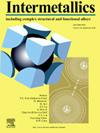Achieving strength-ductility synergy in HIP-CoCrFeNiMn high-entropy alloys via rolling and annealing
IF 4.8
2区 材料科学
Q2 CHEMISTRY, PHYSICAL
引用次数: 0
Abstract
Although the rolling-annealing process has been widely employed to tailor the microstructure and mechanical properties of high-entropy alloys, an optimal balance between strength and ductility has yet to be achieved. A deeper understanding of how different rolling modes and deformation levels affect recrystallization behavior and mechanical performance is essential for optimizing processing strategies. In this study, CrMnFeCoNi high-entropy alloys (HEAs) were fabricated by hot isostatic pressing, and the effects of the rolling annealing process on the microstructural evolution and mechanical properties of the alloys were systematically investigated. The results show that the prior particle boundaries (PPBs), composed of oxides, significantly influence the recrystallization behavior of the heavily cold-rolled CrMnFeCoNi HEAs. After annealing, the cold rolled large deformation specimen exhibited a highly inhomogeneous grain size distribution, with fine grains concentrated near the PPBs, accompanied by high kernel average misorientation values. Transmission electron microscopy revealed the presence of high-density dislocations and nanoscale secondary phases in these regions. In contrast, the hot-rolled specimens exhibited a higher fraction of twin boundaries, indicating more complete recrystallization. Mechanical testing demonstrated that the annealed CR75 % (75 % cold rolling reduction) specimen possessed the best combination of strength and ductility (Tensile strength: 782 MPa, Uniform elongation:34.9 %), which can be attributed to the synergistic effects of grain refinement, secondary phase strengthening, and dislocation strengthening. This study underscores the critical role of microstructural heterogeneity in tuning the properties of HEAs and provides a theoretical basis for their microstructural optimization.
通过轧制和退火实现HIP-CoCrFeNiMn高熵合金的强度-塑性协同效应
虽然轧制退火工艺已被广泛用于调整高熵合金的组织和力学性能,但尚未达到强度和塑性之间的最佳平衡。深入了解不同的轧制方式和变形水平如何影响再结晶行为和力学性能是优化加工策略的必要条件。采用热等静压法制备了CrMnFeCoNi高熵合金(HEAs),系统研究了轧制退火工艺对合金组织演变和力学性能的影响。结果表明,由氧化物组成的先验颗粒边界(PPBs)对重冷轧crmnnfeconi HEAs的再结晶行为有显著影响。冷轧大变形试样退火后晶粒尺寸分布极不均匀,细晶粒集中在ppb附近,晶粒平均取向偏差较大。透射电镜显示这些区域存在高密度位错和纳米级二次相。相比之下,热轧试样表现出更高的孪晶边界,表明更完全的再结晶。力学试验表明,退火后的cr75%(75%冷轧压下)试样具有最佳的强度和塑性组合(抗拉强度为782 MPa,均匀伸长率为34.9%),这是晶粒细化、二次相强化和位错强化协同作用的结果。本研究强调了微结构非均质性对HEAs性能调控的重要作用,为其微结构优化提供了理论依据。
本文章由计算机程序翻译,如有差异,请以英文原文为准。
求助全文
约1分钟内获得全文
求助全文
来源期刊

Intermetallics
工程技术-材料科学:综合
CiteScore
7.80
自引率
9.10%
发文量
291
审稿时长
37 days
期刊介绍:
This journal is a platform for publishing innovative research and overviews for advancing our understanding of the structure, property, and functionality of complex metallic alloys, including intermetallics, metallic glasses, and high entropy alloys.
The journal reports the science and engineering of metallic materials in the following aspects:
Theories and experiments which address the relationship between property and structure in all length scales.
Physical modeling and numerical simulations which provide a comprehensive understanding of experimental observations.
Stimulated methodologies to characterize the structure and chemistry of materials that correlate the properties.
Technological applications resulting from the understanding of property-structure relationship in materials.
Novel and cutting-edge results warranting rapid communication.
The journal also publishes special issues on selected topics and overviews by invitation only.
 求助内容:
求助内容: 应助结果提醒方式:
应助结果提醒方式:


